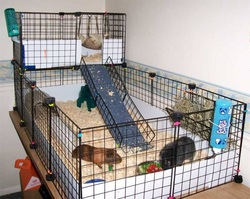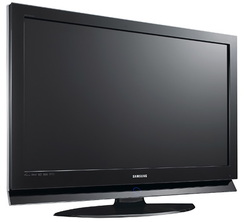Housing
Cage
Bigger is always better! A cage should be large enough for the guinea pig to have a kitchen with the food and water bowls, and bathroom area, a bedroom area, and a play area. The cavy should be able to stand up on his hind legs without hitting his head on the roof of the cage. The minimum size cage for a single guinea pig is 2 ft x 3 ft.
The sides should be wire so piggy can see out and get plenty of fresh air (but not a draft - see below). The sides and top should be secure so your cavy can’t escape and get lost or hurt, and so other pets in the house cannot harm her.
It should have a solid bottom, not a wire one. The wires can injure the cavy’s feet. The bottom should be removable so you can wash it out easily. There should be a door that makes it easy for you to reach in and fill the food bowl and big enough for the guinea pig to walk in and out of.
Location
The cage should be in a location where the cavy can see you without being disturbed too much. She should feel like being part of the family, but not like she’s in the middle of a loud freeway.
Their hearing is very sensitive, so they should not be near a TV or radio.
The cage should also be in a place that gets indirect sunlight. Direct sunlight can overheat and kill a guinea pig. Fireplaces, stoves and heaters can do the same thing.
Drafts can also make your guinea pig sick, so it should not be placed in front of a window or door, and it shouldn’t be on the floor where it can be drafty, especially in winter.
Basements and garages are really bad places for guinea pigs because of the poor light, poor ventilation, moisture, cold, and car exhaust.
If you set up temporary housing as a play area outside, you have even more dangers to think about. You have to make sure it is safe from predators, there are no poisonous plants or other dangers like pesticides, and it is the right temperature. Guinea pigs will die if the temperature is over 80 degrees or if they are in too much sunlight. Make sure you never leave your piggy unattended!
Privacy
Guinea pigs are near the bottom of the food chain, so they can get nervous and try to hide when they sense danger. If you don’t give your piggy a place to hide, he will not feel safe and he will probably act nervous all of the time. Also, they live in burrows in the wild, and most cage floors don’t allow the cavy to dig through the floor very well to make a burrow! You need to provide one!
You can find lots of styles of nest boxes. There are some that are edible so the cavy can sleep in it and keep his teeth in shape at the same time. Bob had one, but she seems to like her plastic castle better. It’s shaped like an igloo, and she likes to pick it up and move it around, and climb on top of it.
Whatever you pick, make sure it is big enough for the guinea pig to turn around inside, and make sure you can keep it clean easily. Bob’s castle is roomy and easy to keep clean. It lets some light in, but it gives her privacy.
Bedding
Some experts say that cedar shavings are bad for the guinea pig’s respiratory system because of the odor. Others say that pine shavings are bad, too, because of the chemicals. Any type of wood shavings can harm your piggy’s eyes. Paper that you shred yourself can also be bad if the ink on it is toxic. Some people use corn cob bedding, others use shredded paper, and others use straw. None of these are good choices because they do not absorb moisture or odors well and they mold quickly.
I use a special soft bedding made for small animals. It is made of recycled paper and doesn’t have any ink. It feels like cloth and doesn’t have much dust.
You should use at least 2 inches of bedding, clean it out often, and do a thorough cleaning at least once a week. Be careful not to use harsh chemicals with strong fumes. Vinegar and water is good, or you can use a mild soap. Be sure to rinse the cage very well.
Remember: If you can smell it, it’s waaaay past time to clean it!
Cage
Bigger is always better! A cage should be large enough for the guinea pig to have a kitchen with the food and water bowls, and bathroom area, a bedroom area, and a play area. The cavy should be able to stand up on his hind legs without hitting his head on the roof of the cage. The minimum size cage for a single guinea pig is 2 ft x 3 ft.
The sides should be wire so piggy can see out and get plenty of fresh air (but not a draft - see below). The sides and top should be secure so your cavy can’t escape and get lost or hurt, and so other pets in the house cannot harm her.
It should have a solid bottom, not a wire one. The wires can injure the cavy’s feet. The bottom should be removable so you can wash it out easily. There should be a door that makes it easy for you to reach in and fill the food bowl and big enough for the guinea pig to walk in and out of.
Location
The cage should be in a location where the cavy can see you without being disturbed too much. She should feel like being part of the family, but not like she’s in the middle of a loud freeway.
Their hearing is very sensitive, so they should not be near a TV or radio.
The cage should also be in a place that gets indirect sunlight. Direct sunlight can overheat and kill a guinea pig. Fireplaces, stoves and heaters can do the same thing.
Drafts can also make your guinea pig sick, so it should not be placed in front of a window or door, and it shouldn’t be on the floor where it can be drafty, especially in winter.
Basements and garages are really bad places for guinea pigs because of the poor light, poor ventilation, moisture, cold, and car exhaust.
If you set up temporary housing as a play area outside, you have even more dangers to think about. You have to make sure it is safe from predators, there are no poisonous plants or other dangers like pesticides, and it is the right temperature. Guinea pigs will die if the temperature is over 80 degrees or if they are in too much sunlight. Make sure you never leave your piggy unattended!
Privacy
Guinea pigs are near the bottom of the food chain, so they can get nervous and try to hide when they sense danger. If you don’t give your piggy a place to hide, he will not feel safe and he will probably act nervous all of the time. Also, they live in burrows in the wild, and most cage floors don’t allow the cavy to dig through the floor very well to make a burrow! You need to provide one!
You can find lots of styles of nest boxes. There are some that are edible so the cavy can sleep in it and keep his teeth in shape at the same time. Bob had one, but she seems to like her plastic castle better. It’s shaped like an igloo, and she likes to pick it up and move it around, and climb on top of it.
Whatever you pick, make sure it is big enough for the guinea pig to turn around inside, and make sure you can keep it clean easily. Bob’s castle is roomy and easy to keep clean. It lets some light in, but it gives her privacy.
Bedding
Some experts say that cedar shavings are bad for the guinea pig’s respiratory system because of the odor. Others say that pine shavings are bad, too, because of the chemicals. Any type of wood shavings can harm your piggy’s eyes. Paper that you shred yourself can also be bad if the ink on it is toxic. Some people use corn cob bedding, others use shredded paper, and others use straw. None of these are good choices because they do not absorb moisture or odors well and they mold quickly.
I use a special soft bedding made for small animals. It is made of recycled paper and doesn’t have any ink. It feels like cloth and doesn’t have much dust.
You should use at least 2 inches of bedding, clean it out often, and do a thorough cleaning at least once a week. Be careful not to use harsh chemicals with strong fumes. Vinegar and water is good, or you can use a mild soap. Be sure to rinse the cage very well.
Remember: If you can smell it, it’s waaaay past time to clean it!


